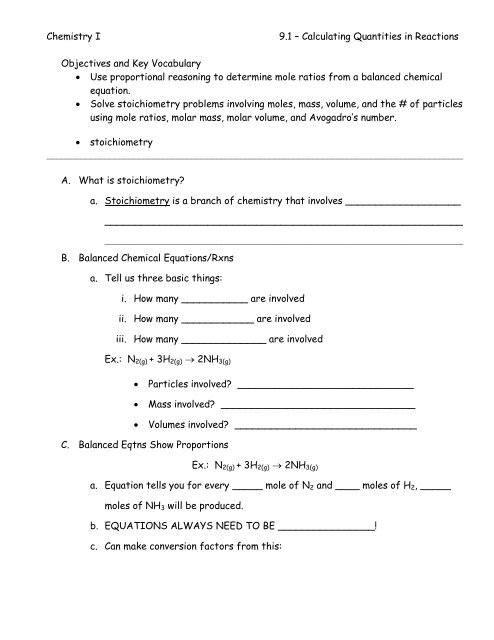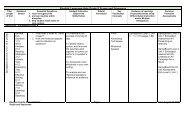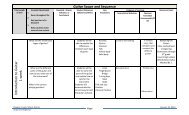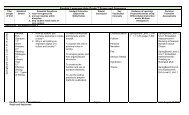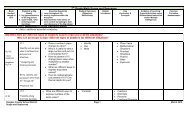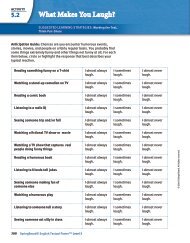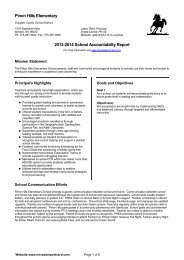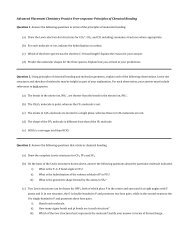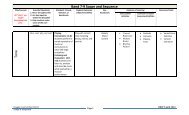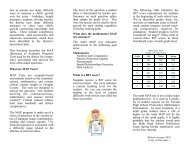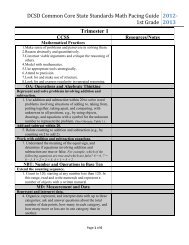Chemistry I 9.1 â Calculating Quantities in Reactions Objectives and ...
Chemistry I 9.1 â Calculating Quantities in Reactions Objectives and ...
Chemistry I 9.1 â Calculating Quantities in Reactions Objectives and ...
You also want an ePaper? Increase the reach of your titles
YUMPU automatically turns print PDFs into web optimized ePapers that Google loves.
<strong>Chemistry</strong> I<strong>9.1</strong> – <strong>Calculat<strong>in</strong>g</strong> <strong>Quantities</strong> <strong>in</strong> <strong>Reactions</strong><strong>Objectives</strong> <strong>and</strong> Key Vocabulary· Use proportional reason<strong>in</strong>g to determ<strong>in</strong>e mole ratios from a balanced chemicalequation.· Solve stoichiometry problems <strong>in</strong>volv<strong>in</strong>g moles, mass, volume, <strong>and</strong> the # of particlesus<strong>in</strong>g mole ratios, molar mass, molar volume, <strong>and</strong> Avogadro‛s number.· stoichiometry______________________________________________________________________________________A. What is stoichiometry?a. Stoichiometry is a branch of chemistry that <strong>in</strong>volves ________________________________________________________________________________________________________________________________________________________B. Balanced Chemical Equations/Rxnsa. Tell us three basic th<strong>in</strong>gs:i. How many ___________ are <strong>in</strong>volvedii. How many ____________ are <strong>in</strong>volvediii. How many ______________ are <strong>in</strong>volvedEx.: N 2(g) + 3H 2(g) ® 2NH 3(g)· Particles <strong>in</strong>volved? _____________________________· Mass <strong>in</strong>volved? ________________________________· Volumes <strong>in</strong>volved? ______________________________C. Balanced Eqtns Show ProportionsEx.: N 2(g) + 3H 2(g) ® 2NH 3(g)a. Equation tells you for every _____ mole of N 2 <strong>and</strong> ____ moles of H 2 , _____moles of NH 3 will be produced.b. EQUATIONS ALWAYS NEED TO BE ________________!c. Can make conversion factors from this:
D. Mole-Mole Calculationsa. Given the # of moles of reactant(s), calculate the number of moles ofproduct(s):Ex.: N 2(g) + 3H 2(g) ® 2NH 3(g)i. How many moles of ammonia are produced when 3.2 mol of hydrogenreact with nitrogen?b. Given the # of moles of product(s), f<strong>in</strong>d the number of moles of reactants(s):Ex.: N 2(g) + 3H 2(g) ® 2NH 3(g)i. How many moles of nitrogen are needed to make 7.24 moles of NH 3 ?E. Mass-Mass Calculationsa. Given the of a reactant or product, calculate the mass of any other reactant orproduct <strong>in</strong> the equationi. Use dimensional analysis <strong>and</strong> go “through” moles. (Go from _______ to_______ to __________.)ii. You‛ll need ____________________!Ex.: N 2(g) + 3H 2(g) ® 2NH 3(g)iii. Calculate the number of grams of NH 3 produced by the reaction of 2.8 gof hydrogen with an excess of nitrogen.
Ex.: N 2(g) + 3H 2(g) ® 2NH 3(g)iv. Calculate the number of grams of N 2 needed to produce 10.0 grams ofNH 3 .F. Other Stoichiometric Calculationsa. Can do calculations between any unit of measurement that is related to themole:i.ii.iii.iv.v.vi. Volume-volume is exception – don‛t need to go through mole!G. Volume-Volume Calculationsa. To calculate volume-volume problems, you don‛t need to go through moles,because molar volume is “mole”.b. Need to remember (or learn) that there are ALWAYS ________ of ONEMOLE of ANY gas at _______ (st<strong>and</strong>ard temperature <strong>and</strong> pressure). Hence,the conversion:c. This can be used <strong>in</strong> other stoichiometry problems <strong>in</strong>volv<strong>in</strong>g volume.
d. What volume of hydrogen is necessary to react with 5.0 liters of nitrogen toproduce ammonia? (Assume STP.)Ex.: N 2(g) + 3H 2(g) ® 2NH 3(g)e. If 15.9 L of C 2 H 2 react at STP, how many moles of CO2 are produced?2C2H 2(g) + 5O 2(g) ® 4CO 2(g) + 2H 2 O (g)f. How many mL of CO 2 can be made when 59.3 mL of O 2 react? (Use above eqtn)H. Many problems, just ONE solution!a. You may th<strong>in</strong>k that you have to try to memorize a bunch of different steps <strong>and</strong>types of stoichiometry problems, but that is not the case.i. Figure your __________ po<strong>in</strong>t <strong>and</strong> ______ po<strong>in</strong>t.ii. Take whatever you are given, <strong>and</strong> convert it <strong>in</strong>to _________.iii. Use mole ratio from __________ equation to convert <strong>in</strong>to whatevercompound you need.iv. F<strong>in</strong>ally, f<strong>in</strong>d a way to convert those moles <strong>in</strong>to the units that you needfor your f<strong>in</strong>al answer!v. This works for _______ stoichiometry problem!


